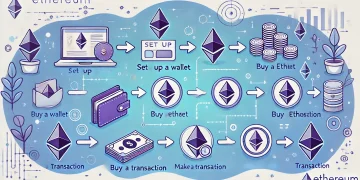The world of cryptocurrency is known for its volatile nature, where prices can rise or fall dramatically within short periods. Investors often find themselves caught between bull and bear markets, terms that describe the overall trend of the market. A bull market signifies a period of sustained price increases and optimism, while a bear market reflects declining prices and pessimism. Successfully navigating these two contrasting market phases is crucial for maximizing gains and minimizing losses in the crypto space. This article will delve deep into the dynamics of bull and bear markets in cryptocurrency, providing insights and strategies to help you navigate both effectively.
1. What Are Bull and Bear Markets in Crypto?
Bull Market
A bull market refers to a prolonged period during which the prices of cryptocurrencies are rising, often driven by strong investor confidence, increasing demand, and positive market sentiment. During this phase, optimism prevails, and investors are generally more willing to take risks, anticipating future price gains.
- Characteristics of a Bull Market:
- Rising Prices: Prices of cryptocurrencies trend upward consistently.
- Increased Trading Volume: High buying interest and trading activity.
- Market Optimism: Positive sentiment across the market, with investors believing that prices will continue to rise.
- Higher Valuations: The market value of projects and tokens increase, with some reaching all-time highs.
Bear Market
In contrast, a bear market signifies a period where cryptocurrency prices decline over an extended time, often fueled by widespread fear, uncertainty, and doubt (FUD). Investors tend to sell off their holdings, anticipating further losses, which exacerbates the downward trend.
- Characteristics of a Bear Market:
- Falling Prices: Consistent price declines across major cryptocurrencies.
- Low Trading Volume: Reduced buying activity as investors become risk-averse.
- Market Pessimism: Investors expect further declines, leading to a “sell-off” mentality.
- Valuation Drops: Market capitalizations shrink, and many tokens may lose a significant portion of their value.
2. Causes of Bull and Bear Markets in Crypto
Understanding the factors that lead to bull and bear markets is key to navigating these phases successfully.
Causes of a Bull Market
- Positive News and Adoption: Bull markets are often sparked by major technological advancements, mainstream adoption, favorable regulations, or institutional investments. For instance, the bull run in 2021 was partially driven by companies like Tesla and MicroStrategy adding Bitcoin to their balance sheets.
- Macroeconomic Factors: Low-interest rates, quantitative easing, and inflationary concerns may push investors toward crypto as a hedge against traditional fiat currencies.
- Increased Demand: Retail and institutional investors entering the market en masse, along with the rise of decentralized finance (DeFi) and non-fungible tokens (NFTs), can fuel demand, pushing prices higher.
Causes of a Bear Market
- Negative News and Regulation: Harsh regulatory actions, security breaches, or macroeconomic instability can trigger a bear market. The 2018 crypto bear market, for example, followed regulatory crackdowns in several countries and the bursting of the initial coin offering (ICO) bubble.
- Market Corrections: After a prolonged bull run, overvaluation or speculative bubbles can lead to a market correction, where prices drop sharply to more realistic levels.
- Loss of Investor Confidence: Bear markets can be exacerbated by a loss of confidence, as investors flee to safer assets or cash out to avoid further losses.
3. How to Navigate a Bull Market in Crypto
While a bull market is often seen as an opportunity to generate significant profits, it is essential to adopt strategies that maximize gains while minimizing risks.
3.1. Take Profits Strategically
During a bull market, it’s tempting to hold onto assets in anticipation of further price increases. However, prices can be unpredictable, and market corrections are inevitable. A strategic approach to taking profits helps secure gains while keeping exposure to further potential upside.
- Set Target Prices: Predefine specific price levels at which you will sell a portion of your holdings to lock in profits. For instance, sell 20-30% of your portfolio once an asset hits a target price.
- Use Trailing Stops: Trailing stops automatically adjust the stop-loss order as the price rises, protecting your profits if the market reverses.
3.2. Avoid Overleveraging
Leveraged trading can amplify gains, but it also increases risk significantly. In a bull market, overleveraging can lead to devastating losses if the market unexpectedly turns bearish.
- Stick to Low Leverage: If using leverage, limit it to low multiples (e.g., 2x or 3x). This reduces the risk of liquidation in case of price dips.
- Keep Debt to a Minimum: Avoid taking on debt to invest in crypto during a bull market, as a sudden downturn could leave you unable to repay.
3.3. Diversify Your Portfolio
Although a rising tide lifts all boats during a bull market, it’s crucial to diversify across different crypto sectors (DeFi, NFTs, layer 1 blockchains, etc.) to spread risk.
- Invest in Multiple Sectors: Allocate capital to various categories of cryptocurrencies. For example, split your portfolio between Bitcoin, Ethereum, DeFi tokens (e.g., Aave, Uniswap), and layer 1 projects (e.g., Solana, Avalanche).
- Hold Stablecoins: Keep a portion of your portfolio in stablecoins like USDC or USDT. These can serve as a hedge against volatility and be used to buy dips.
3.4. Be Cautious of FOMO (Fear of Missing Out)
Bull markets are often accompanied by FOMO, where investors chase rapid price increases without thoroughly evaluating the fundamentals. Jumping into assets based on hype can lead to buying at the peak and suffering losses when the market corrects.
- Stick to Your Strategy: Avoid impulsive buying and stick to your predefined investment strategy. Research thoroughly before purchasing any asset.
- Dollar-Cost Averaging (DCA): DCA involves buying small amounts of an asset at regular intervals, spreading out purchases to reduce the risk of buying at market peaks.
3.5. Consider Staking and Yield Farming
During bull markets, staking or participating in yield farming can generate additional passive income from your crypto holdings, further enhancing profits.
- Staking Rewards: Many blockchain networks (e.g., Ethereum 2.0, Polkadot, Cardano) offer staking rewards for locking up tokens, providing a way to earn passive income while holding onto your assets.
- Yield Farming in DeFi: Yield farming involves providing liquidity to decentralized exchanges (DEXs) and earning fees or rewards. However, assess the risks of impermanent loss and smart contract vulnerabilities before participating.
4. How to Navigate a Bear Market in Crypto
Bear markets can be brutal, but they also offer opportunities for long-term investors who know how to navigate the downturn effectively.
4.1. Hold Strong and Avoid Panic Selling
During a bear market, prices often drop significantly, triggering fear and panic selling. Selling in panic can lock in losses, especially if the market eventually recovers.
- Stick to Long-Term Convictions: If you believe in the long-term fundamentals of your investments, it’s important to avoid making emotional decisions based on short-term price movements.
- Zoom Out: Bear markets can last for extended periods, but cryptocurrencies like Bitcoin and Ethereum have historically rebounded after previous downturns. Keep a long-term perspective when evaluating your investments.
4.2. Accumulate During the Dip (Buy the Dip)
Bear markets can offer a golden opportunity to accumulate high-quality assets at significantly lower prices. While it can be nerve-wracking to buy during price declines, dollar-cost averaging (DCA) can mitigate the risks of catching falling knives.
- DCA Strategy: Regularly invest small amounts regardless of market conditions to smooth out entry points over time.
- Focus on Strong Fundamentals: Accumulate assets with strong use cases, developer activity, and growing ecosystems, as these are more likely to recover when the market turns bullish again.
4.3. Rebalance Your Portfolio
Bear markets offer a chance to rebalance your portfolio by selling overvalued assets and reallocating to undervalued ones. This strategy can position your portfolio for better growth when the market recovers.
- Trim Overexposed Positions: Reduce your exposure to assets that have underperformed or have higher risk, and shift capital to more stable or undervalued projects.
- Increase Stablecoin Holdings: Consider increasing your holdings in stablecoins during bear markets. Stablecoins provide liquidity and can be used to buy assets at lower prices.
4.4. Staking and Earning Yield During Bear Markets
Staking or earning yield through DeFi can provide steady returns during bear markets, helping offset losses from declining asset prices.
- Safe Staking Platforms: Choose reputable networks and projects for staking, as high-risk projects can collapse in bear markets.
- Stablecoin Yield: Use stablecoins to earn yield on DeFi platforms or centralized exchanges, providing a safer way to earn interest without being exposed to volatility.
4.5. Watch for Capitulation
Capitulation refers to the point in a bear market when investors give up on the market, leading to large sell-offs and steep price drops. While painful, capitulation often signals the final stages of a bear market, after which prices can stabilize and eventually recover.
- Capitulation as a Buying Opportunity: While predicting capitulation is difficult, it can provide a major buying opportunity for those prepared to enter the market at low prices.
- Stay Informed: Monitor market sentiment and key indicators like trading volumes, on-chain data, and social media activity to gauge when capitulation might occur.
4.6. Learn and Research During the Bear Market
Bear markets offer a valuable opportunity to deepen your understanding of blockchain technology, cryptocurrency fundamentals, and emerging trends. With fewer distractions from hype, take the time to research projects, expand your knowledge, and prepare for the next bull market.
- Deep Dive Into Fundamentals: Study the whitepapers and roadmaps of projects you’re invested in or interested in to better understand their long-term potential.
- Network and Engage: Participate in crypto communities, forums, and events to stay connected with industry trends and new opportunities.
5. Frequently Asked Questions (FAQs)
1. What is a bull market in crypto?
A bull market is a period of sustained price increases in the cryptocurrency market, characterized by optimism, rising demand, and increased trading activity.
2. What is a bear market in crypto?
A bear market is a prolonged period of declining prices in the crypto market, marked by pessimism, reduced demand, and lower trading volumes.
3. How long do bull and bear markets last?
Bull and bear markets can last anywhere from several months to years, depending on broader market conditions, adoption trends, and macroeconomic factors.
4. Should I sell my crypto during a bear market?
Selling during a bear market can lock in losses, especially if the market eventually recovers. Instead, long-term investors often choose to hold their assets or accumulate more during dips.
5. How can I protect my investments during a bear market?
Diversifying your portfolio, accumulating stablecoins, staking, and avoiding panic selling are effective strategies for protecting your investments during a bear market.
6. What is the best strategy for navigating a bull market?
In a bull market, it’s important to take profits strategically, avoid overleveraging, diversify, and participate in staking or yield farming to maximize gains.
6. Conclusion
Navigating bull and bear markets in cryptocurrency requires a balanced approach of discipline, patience, and strategy. During a bull market, taking profits and managing risks are crucial to securing gains, while bear markets offer unique opportunities to accumulate assets at discounted prices. By understanding the dynamics of both market phases and employing smart investment strategies, you can not only survive but thrive in the volatile world of crypto.

















![Bitcoin Mining in [Current Year] Is It Still Profitable](https://thecryptoweek.com/wp-content/uploads/2024/09/Bitcoin-Mining-in-2024-Is-It-Still-Profitable-75x75.webp)










